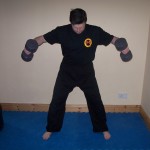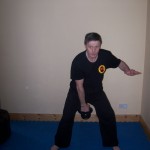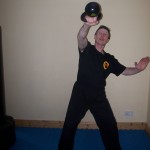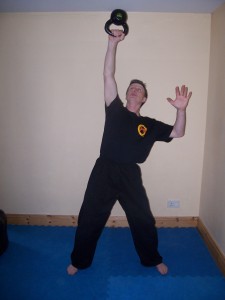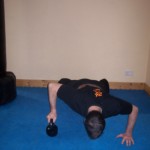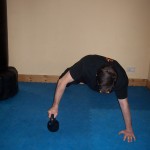Weight Training for Taekwondo and Fitness
AN INTRODUCTION TO RESISTANCE AND WEIGHT TRAINING
Strength or Weight training, sometimes known as Resistance training, will enhance boxing martial arts and fitness. Even the high kicking art of Taekwondo will benefit, as research has shown when resistance and flexibility training are combined, flexibility actually increases. I have only a basic routine myself, I do not do split routines but just the main body parts, however I am regular, as this is important, and try to workout every other day for between 30 to 40 minutes. I use weight equipment that are versatile, easy to store and maintain.
Start off your training always with a warm up, even in warm weather, rotate all the joints and go through the full range of movement. Learn the correct posture and lifting technique before loading heavy weights. The concept of progressive overload basically is increasing weight bit by bit. Perform easy movements while controlling your stability. Exhale during the exercise especially the part where it is more challangeing. Like in a squat inhale when you squat down and exhale when you stand up. I use a protective weight lifting belt as a preventative as most of my training is done in my back garden and it gets a bit cold there in winter. In a senior Black Belt Kaizendo Fitness Class the amount of weight we use is relatively low (1.5kg – 4.5 kg), and most is aimed at the core with the 5 kg weights, while with smaller weights we work on keeping the number of repetitions high, so we’re working on endurance more than strength gain.
Lifting light to medium weight with high repetitions will yield toning and endurance and lifting heavy weights with low repetitions will give muscle growth and power. Overall any load bearing exercise increases bone density and this is important as we age for both men and women. It also prevents osteoporosis and while some say weight training can be boring, being creative with the routines and some backround music helps. The payback is an amazing capacity for endurance.
Once the exercises become easy and you are breezing through the routine you must either increase the load or else increase the difficulty of the exercise. As a side note, once any exercise becomes easy you must modify it for some gain.
Warm up each muscle with a light weight before you move on to a heavy one, especially if you are exercising in cold conditions. As you get into weight training, do not go over board, it is best to take a rest day between workouts. Again wearing a support belt will prevent injury.
· DUMBBELLS
These come mostly already prepared in set molded weights from 1kg up to 16 kg or more. If they are not already made up the dumbbell bar can be tailor made or loaded to suit the individual and exercise. A pair of dumbbells is one of the best pieces of kit because they are easy to store and transport and a light pair can be used for most punching techniques. A pair of 3.5 kg dumbbells may not be hardcore enough at first glance to most men but if you want to build endurance and cardio vascular fitness, try running on the spot for 3 minutes while doing shoulder presses, and you will see how versatile they are. I recommend that once a person becomes a Black Belt after four years of fitness and martial arts training, a light pair of dumbbells should always be in the kit bag. Resist the need to complain about dragging it around if you’re a Black Belt, you’re tough enough anyway. I got this idea from reading about the Irish Boxer Barry McGuigan. When he was younger, waiting in turn for his fight to come, he would have a set of dumbbells in his car and rather than waste training time, he worked away.
While a serious practitioner needs extra loading to build strength, this would be the only one disadvantage, as there is a loading limit on dumbbells.
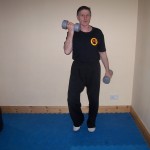
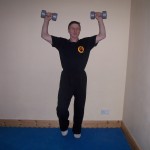 The pictures here show where I am combining jogging on the spot as well as lifting light weight like bicep curls as well as shoulder presses. Light weights are fantastic for shadow boxing. Try a pair of light dumbbells and a tennis ball held between your chin and your chest as you do a 2 or 3 minute round of shadow boxing.
The pictures here show where I am combining jogging on the spot as well as lifting light weight like bicep curls as well as shoulder presses. Light weights are fantastic for shadow boxing. Try a pair of light dumbbells and a tennis ball held between your chin and your chest as you do a 2 or 3 minute round of shadow boxing.
· BARBELLS
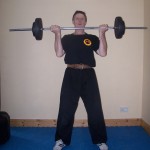
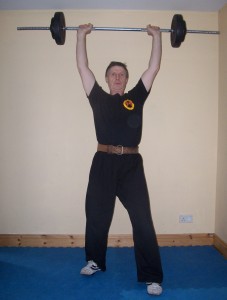 These are a great tool and I would recommend them if you are after building strength. The squat, dead lift, bench and shoulder press are the main exercises. The barbell can also be loaded up to almost 300 kg, so the loading is a great advantage if you want to build strength. The disadvantages are that you may need a bench for the bench press, and a rack for the shoulder, or military presses. The barbell itself is around seven foot long, so storing this as well as the plates may be a challenge if you don’t have much room. It is also difficult to transport easily.
These are a great tool and I would recommend them if you are after building strength. The squat, dead lift, bench and shoulder press are the main exercises. The barbell can also be loaded up to almost 300 kg, so the loading is a great advantage if you want to build strength. The disadvantages are that you may need a bench for the bench press, and a rack for the shoulder, or military presses. The barbell itself is around seven foot long, so storing this as well as the plates may be a challenge if you don’t have much room. It is also difficult to transport easily.
-
A CHIN UP BAR
This is also known as a pull up bar. One of my female Kaizendo Black Belts Petra Stumpfova from the Czech Republic, is also the current women’s world power lifting champion. She squatted an incredible 264 KGS in the World Power lifting Championships atCalgary,Canada, in October 2007. When I asked her what one piece of equipment should I get to build up strength, she recommended that I get a chin up bar.
It is in a class of its own when it comes to upper body strength and it is very affordable. You simply grab the bar which is set just above your arms, reach and pull your entire weight up and lower it down. There is one on the market that will adjust to any door frame and therefore can also double up as a sit up bar, where you can place your feet in between the bar and the floor for sit ups. Again this is simple adjustable, affordable and effective.
· KETTLEBELLS
These are an old training device that was used by the Russian military for many years as far back as the eighteen hundreds. Its effectiveness in the development of power, endurance, core stability and agility cannot be understated. At it’s crudest it is a big ball of iron with a handle welded to it. This causes the weight to pull against your hand requiring strength as well as co-ordination. For all types of martial art training it’s perfect. It is available in a range of weights and colours, where the ball is rubber coated with a rubber base. In recent years the kettle bell has made a revival and now every gym has them. They are easily portable and take very little space compared to regular weights.
If you want to build strength alone, then progressive resistance training with barbells will be better, however for many new converts to the fitness bug, the kettle bell is here to stay and more and more people have experienced both the cardio and muscular endurance benefits of Kettle bell training. Begin with some light weight KettleBellas it takes a while to adjust to the way the weight is distributed.

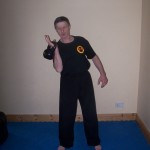
A B
C
The pictures above show a single bicep curl and a shoulder press. I am using a 9 kg bell here and it took me a while to get literally into the swing of it. In this curl and press, turn the bell around slowly, because if you lift it up too quickly it plonks at the back of your wrist. In picture B, I am first turning it before lifting.
Here I am Holding the Bell in a squatting position with your feet apart and lift the bell over your head, a great core exercise because it engages the entire midsection. Be sure to thrust your hips forward as you lift.
Here I am doing an elevated press up where one part of the chest is stretched while the opposite side is performed in the normal way. Holding the handle will ensure that you work stability as well. This is a great exercise and best done with a small heavy medicine ball.
Care is required when storing kettlebells because if you knock the handles together hard it may chip the handles and this tiny chip may tear your hand even with the slightest chip.
· LEGWEIGHTS and WEIGHTED VESTS
I began using leg weights in my Taekwondo Training. I found them excellent but some trainers may not share my enthusiasm. I did injure myself a few times due to over indulgence especially kicking with small leg weights. They are excellent if you are doing some controlled leg swings, (Ballistic Stretches) or just walking around in them to load the legs on days you are training just the legs. Weighted vests are even better as they distribute the load across your entire body. They provide extra loading when doing common bodyweight exercises such as press ups, sit ups, squats and especially chin ups. Both these pieces of equipment are easy to transport, store and are easily affordable.
 The photo shows some of my kit that I mostly train with these days, timer, rope, leg weights, two small dumb bells and a small resistance band. Not shown are bag mitts, boxing gloves, mouthguard, headguard and a pair of focus pads.
The photo shows some of my kit that I mostly train with these days, timer, rope, leg weights, two small dumb bells and a small resistance band. Not shown are bag mitts, boxing gloves, mouthguard, headguard and a pair of focus pads.
· RESISTANCE BANDS
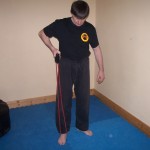 These rubber bands, sometimes called tubes, are very versatile and their greatest advantage is their portability as they weigh very little. They are like giant elastics and have handles at each end. Available in different sizes, they have different strength gauges and can be the best substitute when you are traveling and spending time away from your usual environment and cannot access regular weights. Lunges, chest extensions, triceps extensions, and lateral raises can all be performed easily. Some upper body exercises require that you wrap the band around a solid object like a circular concrete pillar. So if you’re living in Greece, or on holiday and attending an outdoor Boot camp, this exercise is ideal….
These rubber bands, sometimes called tubes, are very versatile and their greatest advantage is their portability as they weigh very little. They are like giant elastics and have handles at each end. Available in different sizes, they have different strength gauges and can be the best substitute when you are traveling and spending time away from your usual environment and cannot access regular weights. Lunges, chest extensions, triceps extensions, and lateral raises can all be performed easily. Some upper body exercises require that you wrap the band around a solid object like a circular concrete pillar. So if you’re living in Greece, or on holiday and attending an outdoor Boot camp, this exercise is ideal….
So this is just the tip of the iceberg but should give you an idea how to get started with some weight training. Much of what I have shown in this blog can be done at home and is great for home practice.
Keep up the training and enjoy being healthy.
With Respect
Frank Murphy





